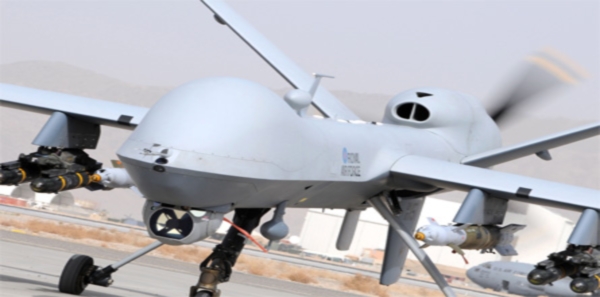The UK Ministry of Defence has outlined its planned schedule to field a follow-on batch of five General Atomics Aeronautical Systems MQ-9 Reaper unmanned aircraft, and revealed details of the operational demands being placed on the Royal Air Force’s current fleet. RAF Reapers have flown missions totalling more than 25,000h from Kandahar airfield in Afghanistan since their introduction in 2007, controlled by a contingent based at the US Air Force’s Creech AFB in Nevada.
Its aircraft are typically flown on 12-hour sorties at altitudes between 20,000ft (6,100m) and 30,000ft, armed with four Lockheed Martin AGM-114 Hellfire air-to-surface missiles and two Raytheon GBU-12 Paveway II 226kg (500lb) bombs. Some 190 weapons have been used so far, with roughly 75% of this total being Hellfires.
“The beauty of the Reaper is that it can hang around on the target for hours on end,” said Wingg Commander Gary Coleman, from the MoD’s HQ 2 Group ISTAR (Land) organisation. “It is really trail-blazing the future ways of doing business.”
Deliveries under the follow-on order will commence in 2012, with current plans calling for the MoD’s urgent operational requirement deal to conclude in March 2015. However, options exist to extend this in one-year instalments, and potentially allow the UK to bridge the gap until the planned introduction of its Scavenger medium-altitude, long-endurance unmanned air system from 2018.
Earlier this year the MoD revealed plans to establish a new mission control element for the Reaper at RAF Waddington, in Lincolnshire, as additional aircraft are introduced. However, Coleman said the service is investigating the possibility of also retaining capability in the USA, to better support its operations in Afghanistan.
Since September 2010, the UK’s Reaper force has been capable of delivering 36h of intelligence, surveillance, target acquisition and reconnaissance cover each day, supported by 21 crews. The forthcoming expansion will see this rise to providing up to three 24-hour “orbits” continuously, with an increased total of 44 crews.
The RAF’s fleet-leader has now accumulated more than 9,500 flight hours, Coleman said. “That aircraft will be out of life by 2015, because of the colossal amount that we’re using it,” he told the UK Air Warfare Centre’s remotely piloted air systems symposium in Shrivenham, Wiltshire, on 8 September. The type has demonstrated an airframe and sensor reliability rate of over 95% since entering use, he added.
Plans for the UK’s Scavenger capability are yet to be finalised, with options potentially to include acquiring the BAE Systems/Dassault-backed Telemos, Cassidian-developed Talarion, or even extending use of the Reaper.
Source: Flight Global

